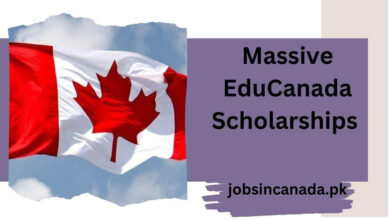Canada Study Visa 2025 – Latest Update

Canada has a long history of serving as a global hub for education, attracting students from all corners of the globe due to its exceptional universities, diverse cultural heritage, and promising employment opportunities following graduation. The Canadian study visa market underwent a substantial transformation as a result of the implementation of the Trusted Institution Framework.
We will embark on a journey through The Trusted Institution Framework to gain insight into its history, the necessity for change, the primary motivations behind its implementation, and the potential impact on international students who aspire to study in Canada.
Background and Need for Change
The country’s status as an appealing destination for international students has resulted in a significant increase in the number of applications for study visas to Canada. However, these new requirements also introduced issues that necessitated immediate attention. The lengthier processing times for visa applications led to student delays and dissatisfaction.
The housing crisis in Canada exacerbated the challenges faced by individuals who were pursuing education and reduced the quality of service. The current system necessitated a comprehensive overhaul due to the financial challenges and uncertainties surrounding post-study employment prospects.
In this post, we will investigate the distinctive challenges faced by international students and the justification behind the Trusted Institution Framework. To provide a comprehensive understanding of the environment in which the new framework was developed, each factor, including the housing crisis and the burden on service standards, will be examined in detail.
Core Reasons for Implementation
The Canada study visa system necessitates modification for three primary reasons.
- Initially, the current system was unable to accommodate the overwhelming volume of study visa applications, resulting in protracted processing delays.
- Secondly, the financial challenges that students encountered, which were exacerbated by inflation and increasing expenditures, necessitated a more student-centered approach.
- Finally, it is imperative that post-study employment opportunities, which are a critical component for international students, are by the labor market’s requirements.
This section will meticulously analyze each of the fundamental causes, underscoring their significance in the development of The Trusted Institution Framework.
Overview of The Trusted Institution Framework
Comparisons with the Student Partnership Program, its predecessor, are essential for a comprehensive comprehension of the new framework. The development of Canada’s strategy for overseeing the admissions of international students can be enriched by comprehending the transition.
The primary components of the framework are delineated in this section, which emphasizes its efforts to resolve concerns and improve the overall study visa application process.
Conditions for Inclusion in Trusted Institution List
The framework for trusted institutions is established by the selection of institutions based on specific criteria. To be included on the esteemed trusted institution list, institutions must satisfy five or six prerequisites. Retention rates, program completion percentages, revenue contributions from overseas students, scholarship offerings, lodging options, and student-teacher ratios are among the factors that significantly influence an institution’s eligibility.
This section meticulously analyzes each condition, elucidating the manner in which they all function in conjunction to improve the framework’s effectiveness.
Implementation Process and Timeline
The procedure of implementing any systemic change is crucial. Important information is provided to stakeholders, particularly potential international students, by understanding the anticipated timing and the manner in which The Trusted Institution Framework will be implemented.
This section also addresses prospective concerns and issues that may arise during the transition. The summary of the implementation process will provide readers with a roadmap for the forthcoming months and years.
Check Also: University of Twente Scholarships – International Students
Benefits for Canada Study Visa
- High-Quality Education: Canada is home to some of the world’s top-ranked universities and colleges, which offer exceptional academic opportunities in a variety of disciplines. This can improve your career prospects, as Canadian education is internationally recognized.
- Working While Studying: International students in Canada are permitted to work on or off-campus for a maximum of 20 hours per week during the academic year and full-time during vacations (summer and winter holidays) to contribute to their financial stability.
- Post-Graduation Work Permit (PGWP): International students may petition for a PGWP after completing a program of study at a Designated Learning Institution (DLI). This permit permits them to work in Canada for a maximum of three years, contingent upon the duration of their program. This may result in the possibility of obtaining permanent residency.
- Pathway to Permanent Residency: A variety of immigration pathways are available to international students who have studied and worked in Canada, including the Canadian Experience Class under the Express Entry program, which is a pathway to permanent residency. This facilitates the transition of graduates into permanent residency.
- Multicultural Environment: Canada is renowned for its inclusive and diverse culture. Studying in Canada offers the opportunity to interact with individuals from various countries, which can assist in the cultivation of a global perspective.
- Health Insurance: The majority of provinces provide health insurance to international students, frequently at minimal or no additional cost, to guarantee that they are adequately insured for medical expenses during their studies.
- Safety and Quality of Life: Canada is consistently ranked as one of the safest countries in the globe. Additionally, it provides a pristine environment, modern infrastructure, and public services, all of which contribute to a high standard of living.
- Research Opportunities: Canadian universities provide innovative research opportunities, particularly in the disciplines of environmental sciences, healthcare, and technology. Students have the opportunity to participate in research initiatives that can contribute to global progress.
- Student Support Services: International students are provided with a diverse array of support services by the majority of Canadian universities, such as academic counseling, career services, and cultural support, to assist them in acclimating to life in Canada.
- Immigration Benefits for Family Members: Your spouse or common-law partner may be eligible to apply for an open work permit while you are studying in Canada, and your children may be able to attend school in Canada.
Comparison with SDS and Future Prospect
By contrasting the Trusted Institution Framework with the Student Direct Stream (SDS), which it replaced, it is possible to develop a more sophisticated comprehension of the modifications and improvements that were implemented. The primary differences are examined in this section, which examines how the new framework addresses the deficiencies of the SDS and adjusts to the evolving requirements of international students.
The Trusted Institution Framework’s prospects are also evaluated, with an emphasis on potential enhancements and modifications that may be implemented as it transitions to full operation.
Fraquality Asked Question:
-
How much money do I need for a study visa in Canada?
As the primary applicant, the student would need to demonstrate funds amounting to $20,635 for the year to cover living expenses. The first accompanying family member requires an additional $5,055 to meet the living expenses for a year.
-
What are the new rules for student visas in Canada?
Effective immediately, eligible students can now work up to 24 hours per week off campus while their classes are in session. Officials clarified dat international students must apply and be approved for a new study permit before changing designated learning institutions.
-
Is Canada giving student visas easily now?
Canadian study permits are in high demand, so, unfortunately, it’s common for applications to be rejected. Getting your application right in the first place can save you lots of stress in money. Here are some of the most common reasons behind rejections, and how to fix them.



